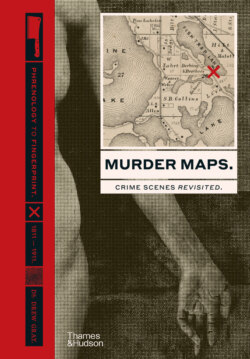Читать книгу Murder Maps - Drew Gray - Страница 21
На сайте Литреса книга снята с продажи.
Оглавление20
PART ONE — EUROPE.
In December 1811, two brutal sets of murders shook London and prompted calls for a more professional police force. A watchman responding to Margaret Jewell’s (dates unknown) cries for help discovered the first. Her master, Timothy Marr (c. 1787–1811), had sent her to fetch some oysters for supper. However, on her return, Margaret found the door locked and received no response to her incessant knocking, prompting the next-door neighbour and a nightwatchman to come to her aid. When they managed to enter through the back of the shop, they found a scene of horror inside. The apprentice, James Gowen (1797–1811), was lying in a pool of blood, his face shattered. Mrs Marr’s (1787–1811) body was nearby, blood still oozing from her head. Her husband was found also beaten to death and their baby boy was upstairs in his cot, his throat cut.
The Marrs lived on the Ratcliffe Highway in Wapping, east London, an area notorious for crime, prostitution and poverty. But this crime was
beyond the imagination of even the most hardened denizen of the Highway and it sent shock waves through the capital. When, twelve days later (19 December), another family was massacred, the panic in east London reached unprecedented heights. A crowd outside the King’s Arms pub watched as lodger John Turner (dates unknown), clad only in his underclothes, descended a makeshift rope to safety. When the onlookers broke in, they found the landlord, John Williamson (1755–1811), lying dead on the cellar steps. He had been beaten and his throat slashed, and defensive wounds to his arms testified to a forlorn attempt to save himself. His wife, Elizabeth (1751–1811), and the family’s maid were found nearby, having suffered a similar fate.
Within days, a man was in custody. John Williams (1784–1811), a 27-year-old sailor and a well-known regular at the King’s Arms, was locked up in Coldbath Fields Prison while investigations continued. A bloodied shipwright’s hammer, or maul, had been found at the Marrs, which seemed to provide some clues. Williams lodged at another pub, the Pear Tree, sharing rooms with a sailor named John Peterson (dates unknown). Peterson was at sea but a maul he owned was missing.
The maul found at the Marrs had the initials ‘J. P.’ carved on it. It looked bad for Williams. But before the suspect could be brought to trial, he was found hanged, apparently having taken his own life.
Deprived of a trial and public execution, the authorities now engaged in a bizarre ritual. Williams’s body was paraded along the Highway on a cart; the maul and a ripping chisel (also suspected of being used in the murders) either side of his head. The cart stopped outside the Marrs’ and the Williamsons’ homes before proceeding to the crossroads at Cannon Street and Cable Street, where Williams was buried in a narrow grave with a stake driven through his heart. This had been a customary way of dealing with suicides in England since the Early Modern period, but was virtually extinct by 1811. In 1886, the remains were dug up during the routine laying of a gas pipe, reviving interest in a case that the East End had tried very hard to forget. •
ecember .
englandlondon.
29 ratcliffe highway, wapping.
the king’s arms, 81 new gravel lane, wapping.
JOHN WILLIAMS. × .
weapon.maul.
typology. reckless act.
policing.parish watch.
